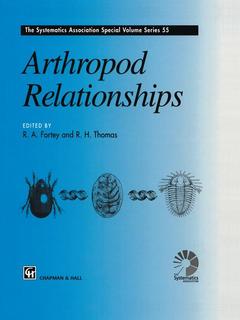Description
Arthropod Relationships, Softcover reprint of the original 1st ed. 1998
The Systematics Association Special Volume Series, Vol. 55
Language: English
Subjects for Arthropod Relationships:
Keywords
Crustacea; Euarthropoda; Evolution; Fauna; Myriapoda; development; embryology; genes; morphology; phylogeny; Model invertebrates
Publication date: 11-2012
383 p. · 21x27.9 cm · Paperback
383 p. · 21x27.9 cm · Paperback
Description
/li>Contents
/li>Comment
/li>
The arthropods contain more species than any other animal group, but the evolutionary pathways which led to their current diversity are still an issue of controversy. Arthropod Relationships provides an overview of our current understanding, responding to the new data arising from sequencing DNA, the discovery of new Cambrian fossils as direct evidence of early arthropod history, and developmental genetics. These new areas of research have stimulated a reconsideration of classical morphology and embryology. ArthropodRelationships is the first synthesis of the current debate to emerge: not since the volume edited by Gupta was published in 1979 has the arthropod phylogeny debate been, considered in this depth and breadth.
Leaders in the various branches of arthropod biology have contributed to this volume. Chapters focus progressively from the general issues to the specific problems involving particular groups, and thence to a consideration of embryology and genetics. This wide range of disciplines is drawn on to approach an understanding of arthropod relationships, and to provide the most timely account of arthropod phylogeny.
This book should be read by evolutionary biologists, palaeontologists, developmental geneticists and invertebrate zoologists. It will have a special interest for post-graduate students working in these fields.
Leaders in the various branches of arthropod biology have contributed to this volume. Chapters focus progressively from the general issues to the specific problems involving particular groups, and thence to a consideration of embryology and genetics. This wide range of disciplines is drawn on to approach an understanding of arthropod relationships, and to provide the most timely account of arthropod phylogeny.
This book should be read by evolutionary biologists, palaeontologists, developmental geneticists and invertebrate zoologists. It will have a special interest for post-graduate students working in these fields.
List of contributors. Preface. 1. Bodyplans, phyla and arthropods; J.W. Valentine, H. Hamilton. 2. The phylogenetic position of the Arthropoda; C. Nielsen. 3. A defence of arthropod polyphyly; G. Fryer. 4. Hox genes and annelid-arthropod relationships; M.H. Dick. 5. Arthropod and annelid relationships re-examined; D.J. Eernisse. 6. Evolutionary correlates of arthropod tagmosis: scrambled legs; M.A. Wills, D.E.G. Briggs, R.A. Fortey. 7. Theories, patterns, and reality: game plan for arthropod phylogeny; M.J. Emerson, F.R. Schram. 8. Sampling, groundplans, total evidence and the systematics of arthropods; W.C. Wheeler. 9. Arthropod phylogeny: taxonomic congruence, total evidence and conditional combination approaches to morphological and molecular data sets; J. Zrzavý, V. Hypsa, M. Vlásková. 10. The place of tardigrades in arthropod evolution; R.A. Dewel, W.C. Dewel. 11. Stem group arthropods from the Lower Cambrian Sirius Passet fauna of North Greenland; G.E. Budd. 12. Cambrian `Orsten'-type arthropods and the phylogeny of Crustacea; D. Walossek, K.J. Müller. 13. Comparative limb morphology in major crustacean groups: the coxa-basis joint in postmandibular limbs; G. Boxshall. 14. Crustacean phylogeny inferred from 18S rDNA; T. Spears, L.G. Abele. 15. A phylogeny of recent and fossil Crustacea derived from morphological characters; M.A. Wills. 16. The fossil record and evolution of the Myriapoda; W.A. Shear. 17. The early history and phylogeny of the chelicerates; J.A. Dunlop,P.A. Selden. 18. Problem of the basal dichotomy of the winged insects; A.P. Rasnitsyn. 19. Arthropod phylogeny and `basal' morphological structures; J. Kukalová-Peck. 20. Advances and problems in insect phylogeny; R. Willmann. 21. The groundplan and basal diversification of the hexapods; N.P. Kristensen. 22. Phylogenetic relationships between higher taxa of tracheate arthropods; O. Kraus. 23. Myriapod&endash;insect relationships as opposed to an insect&endash;crustacean sister group relationship; W. Dohle. 24. Cleavage, germ band formation and head segmentation: the ground pattern of the Euarthropoda; G. Scholtz. 25. Homology and parallelism in arthropod sensory processing; D.-E. Nilsson, D. Osorio. 26. The organization and development of the arthropod ventral nerve cord: insights into arthropod relationships; P.M. Whitington, J.P. Bacon.
This book provides a new summary and a new perspective by bringing together morphologists, paleontologists, geneticists, and molecular biologists for a new appraisal of the relationships between arthropods, the articles will provide a thorough new synthesis of problems that have been intractable for years.
© 2024 LAVOISIER S.A.S.




